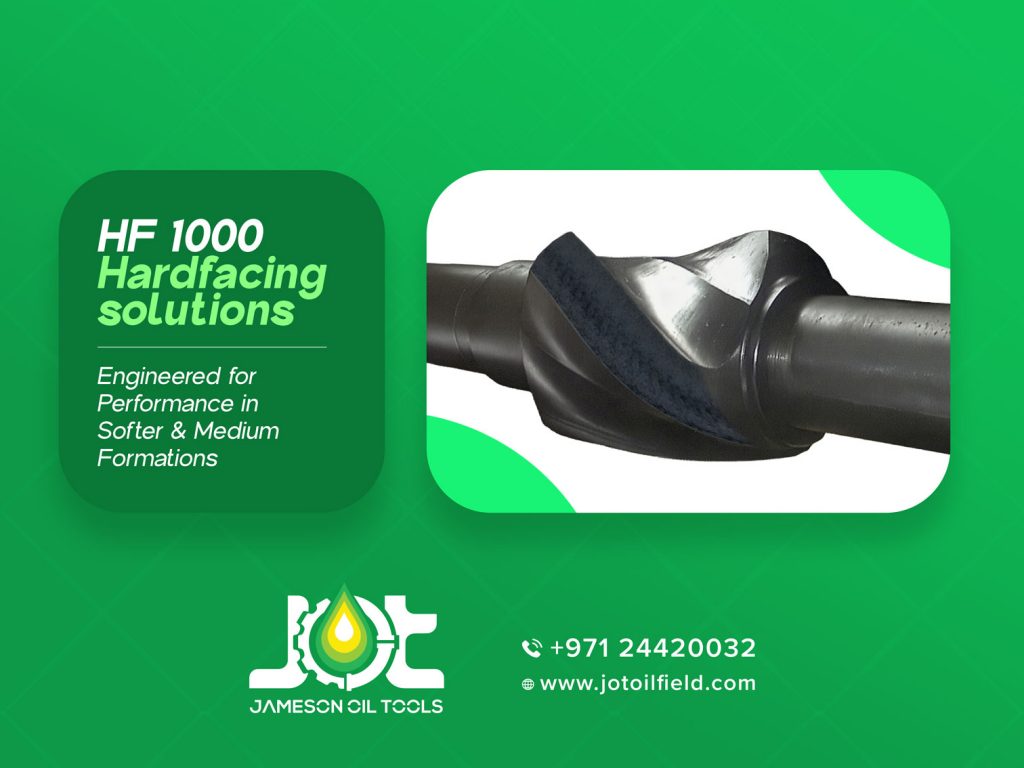

In the demanding world of oil and gas drilling, equipment durability can make the difference between a successful operation and costly downtime. One technology that’s revolutionizing how drilling contractors protect their tools in softer and medium formations is HF 1000 hardfacing—a cost-effective, proven solution that extends the life of critical drilling components while maintaining operational efficiency.
At JOT Oilfield Services, we’ve leveraged HF 1000 hardfacing technology to help drilling contractors across the UAE, Oman, and Saudi Arabia maximize their equipment investment and reduce their total cost of operations. But what exactly makes HF 1000 so effective for softer formations, and when should you choose it over other hardfacing options?
HF 1000 is a cost-effective hardfacing solution that uses crushed tungsten carbide particles held in a nickel bronze matrix. The unique 3mm grain size of the tungsten carbide ensures greater concentration of carbide particles, making it ideal specifically for drilling operations in soft to medium formation environments.
The HF 1000 hardfacing process applies tough molten carbide particles through an oxy-acetylene welding method, where these particles are suspended and bonded in a nickel bronze matrix. This composition provides:
The 3mm grain size is particularly important—it delivers a higher concentration of wear-resistant carbide particles while maintaining a matrix that can absorb some impact without failing, making it the perfect balance for softer, less abrasive formations.
Drilling formations are typically classified into categories:
Softer and medium formations, while less abrasive than hard rock, present unique challenges requiring specially engineered protection.
In these formation types, drilling tools experience:
Abrasion: Gradual wearing away by sand and silt particles as the drill string slides against the wellbore wall
Erosion: Particle impact and fluid flow effects that slowly diminish component dimensions
Plastic deformation: Localized material flow and micro-cracking from moderate impact forces
Corrosive wear: Chemical interaction with formation fluids and drilling mud
HF 1000 hardfacing specifically addresses these mechanisms through its crushed tungsten carbide composition, which presents numerous hard particles to intercept abrasive contact.
Stabilizers are among the most critical tools in the drill string, and they experience constant wear in soft formations. JOT applies HF 1000 hardfacing to the blades of drill string stabilizers, creating a protective surface that:
In deviated wells and horizontal sections, motor sleeves take significant wear. HF 1000 hardfacing extends the operational life of these critical components while maintaining the tight tolerances required for proper motor function.
When opening the wellbore in soft formations, reamers face continuous abrasion. HF 1000 hardfacing provides the protection needed to maintain gauge without excessive tool wear.
Even fishing operations benefit from HF 1000 protection, as these tools contact the wellbore and other downhole components repeatedly during recovery operations.
At JOT Oilfield Services, we follow a rigorous process to ensure maximum effectiveness and longevity of HF 1000 hardfacing:
All tools are cleaned and prepared to remove mill scale, corrosion, and contaminants. Proper surface preparation is critical—poor preparation leads to inadequate bonding and premature failure.
Components are pre-heated to approximately 400-500°C to reduce thermal shock and improve carbide particle bonding during the welding process.
Our certified welding engineers apply the crushed tungsten carbide composite material using precise oxy-acetylene torch techniques. Multiple passes may be applied depending on wear specifications and component geometry.
Post-weld heat treatment and controlled cooling prevent stress concentration and ensure the hardfaced layer maintains its integrity.
Every hardfaced component undergoes rigorous inspection including:
Our ASNT Level 2 Inspectors and Certified Welding Inspectors ensure every component meets international standards.
It’s important to understand HF 1000’s limitations:
Formation hardness exceeds UCS 40,000 psi: Harder formations require more aggressive hardfacing grades for optimal protection and tool longevity.
Extreme abrasion environments: High-abrasive sandstone or granite formations need premium grades with higher carbide concentration to withstand intensive wear.
Geothermal wells exceeding 350°C: Special geothermal hardfacing is required due to temperature limitations of the nickel bronze matrix.
Ultra-high deviation wells: Extreme dogleg situations may benefit from premium hardfacing to handle significant impact stress and complex wellbore dynamics.
JOT Oilfield Services has built its reputation on technical excellence in hardfacing operations. Our advantages include:
Drilling contractors operating in UAE soft formation fields have reported:
These benefits add up quickly in high-activity drilling regions, making HF 1000 hardfacing a smart operational decision.
When ordering HF 1000 hardfacing services from JOT, specify:
Our technical team will assess whether HF 1000 is optimal for your specific application or recommend alternative hardfacing grades if your formation characteristics warrant different protection.
HF 1000 hardfacing represents a time-tested, cost-effective solution for extending the operational life of drilling tools in soft and medium formation environments. By combining crushed tungsten carbide’s wear resistance with the impact tolerance of a nickel bronze matrix, HF 1000 delivers the optimal balance of durability and economy.
Whether you’re drilling development wells in UAE fields or conducting exploration work in Oman or Saudi Arabia, properly hardfaced tools equipped with HF 1000 protection will reduce your total cost of operations, minimize downtime, and improve drilling predictability.
At JOT Oilfield Services, we bring three decades of combined expertise in hardfacing technologies to every project. Our ASNT-certified welding engineers and inspectors understand the unique demands of Middle Eastern oilfields and deliver hardfacing solutions that perform consistently under real-world conditions.
Ready to extend your tool life and reduce drilling costs? Contact JOT today for a consultation on HF 1000 hardfacing for your operations in the UAE, Oman, or Saudi Arabia.
Browse our comprehensive catalogue for a diverse range of high-quality oil and gas equipment solutions.